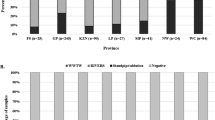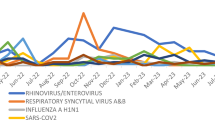Abstract
Rotavirus is a major cause of acute gastroenteritis in infants and young children, while its role as a pathogen in adults has long been underappreciated. In order to describe the epidemiological patterns and genetic characteristics of rotavirus causing sporadic acute gastroenteritis in adults, hospital-based surveillance of rotavirus infections was conducted in Shanghai, China, between June 2010 and May 2011. Stool specimens were collected from outpatients with acute gastroenteritis admitted to three local hospitals. Rotavirus was detected using a colloidal gold test device. G and P genotyping were performed by multiplex PCR assays, and the VP7 gene of G9 strains were sequenced for further genetic characterization. Of 1,479 adult diarrheal stool samples examined during the 1-year surveillance period, 138 (9.3 %) were found to be rotavirus positive. G1 appeared to be the predominant genotype (35.5 %), suggesting a shift from genotype G3 to G1 in the study population in Shanghai. Meanwhile, a high frequency of genotype G9 (27.5 %) was also observed, and G9 was also predominant (38.1 %) in the small number of children (n=123) involved in the present study. Other specificities detected in adults were G2 (12.3 %) and G3 (13.8 %). For P genotyping, only two types, P[8] and P[4], were detected. P[8] was dominant in both children and adults. Sequence and phylogenetic analysis revealed that these strains could be divided into two different groups, with clustering within G9 lineage 3 and the subcluster of Japanese and Chinese G9 strains, respectively. In comparison to the previous data, G9 strains established themselves in a short time span as an important genotype in Shanghai, China.




Similar content being viewed by others
References
Tate JE, Burton AH, Boschi-Pinto C, Steele AD, Duque J, Parashar UD (2012) 2008 estimate of worldwide rotavirus-associated mortality in children younger than 5 years before the introduction of universal rotavirus vaccination programmes: a systematic review and meta-analysis. Lancet Infect Dis 12:136–141
Angel J, Franco MA, Greenberg HB (2007) Rotavirus vaccines: recent developments and future considerations. Nat Rev Microbiol 5:518–529
Hrdy DB (1987) Epidemiology of rotaviral infection in adults. Rev Infect Dis 9:461–469
Anderson EJ, Weber SG (2004) Rotavirus infection in adults. Lancet Infect Dis 4:91–99
Dupuis P, Beby A, Bourgoin A, Lussier-Bonneau MD, Agius G (1995) Epidemic of viral gastroenteritis in an elderly community. Presse Med 24:356–358
Ryan MJ, Wall PG, Adak GK, Evans HS, Cowden JM (1997) Outbreaks of infectious intestinal disease in residential institutions in England and Wales 1992–1994. J Infect 34:49–54
Griffin DD, Fletcher M, Levy ME, Ching-Lee M, Nogami R, Edwards L (2002) Outbreaks of adult gastroenteritis traced to a single genotype of rotavirus. J Infect Dis 185:1502–1505
Marshall J, Botes J, Gorrie G, Boardman C, Gregory J, Griffith J (2003) Rotavirus detection and characterisation in outbreaks of gastroenteritis in aged-care facilities. J Clin Virol 28:331–340
Grimwood K, Abbott GD, Fergusson DM, Jennings LC, Allan JM (1983) Spread of rotavirus within families: a community based study. Br Med J (Clin Res Ed) 287:575–577
Kim HW, Brandt CD, Kapikian AZ, Wyatt RG, Arrobio JO, Rodriguez WJ (1977) Human reovirus-like agent infection. Occurrence in adult contacts of pediatric patients with gastroenteritis. JAMA 238:404–407
Anderson EJ, Katz BZ, Polin JA, Reddy S, Weinrobe MH, Noskin GA (2012) Rotavirus in adults requiring hospitalization. J Infection 64:89–95
Thomas PD, Pollok RC, Gazzard BG (1999) Enteric viral infections as a cause of diarrhoea in the acquired immunodeficiency syndrome. HIV Med 1:19–24
Iturriza-Gomara M, Green J, Brown DW, Ramsay M, Desselberger U, Gray JJ (2000) Molecular epidemiology of human group A rotavirus infections in the United Kingdom between 1995 and 1998. J Clin Microbiol 38:4394–4401
Pietruchinski E, Benati F, Lauretti F, Kisielius J, Ueda M, Volotao EM (2006) Rotavirus diarrhea in children and adults in a southern city of Brazil in 2003: distribution of G/P types and finding of a rare G12 strain. J Med Virol 78:1241–1249
Wang YH, Kobayashi N, Zhou DJ, Yang ZQ, Zhou X, Peng JS (2007) Molecular epidemiologic analysis of group A rotaviruses in adults and children with diarrhea in Wuhan city, China, 2000–2006. Arch Virol 152:669–685
Wang YH, Zhou X, Ghosh S, Zhou DJ, Pang BB, Peng JS (2011) Prevalence of human rotavirus genotypes in Wuhan, China, during 2008–2011: changing trend of predominant genotypes and emergence of strains with the P[8]b subtype of the VP4 gene. Arch Virol 156:2221–2231
Iturriza-Gomara M, Kang G, Gray J (2004) Rotavirus genotyping: keeping up with an evolving population of human rotaviruses. J Clin Virol 31:259–265
Simmonds MK, Armah G, Asmah R, Banerjee I, Damanka S, Esona M (2008) New oligonucleotide primers for P-typing of rotavirus strains: Strategies for typing previously untypeable strains. J Clin Virol 42:368–373
Gouvea V, Glass RI, Woods P, Taniguchi K, Clark HF, Forrester B (1990) Polymerase chain reaction amplification and typing of rotavirus nucleic acid from stool specimens. J Clin Microbiol 28:276–282
Gentsch JR, Glass RI, Woods P, Gouvea V, Gorziglia M, Flores J (1992) Identification of group A rotavirus gene 4 types by polymerase chain reaction. J Clin Microbiol 30:1365–1373
Tcheremenskaia O, Marucci G, De Petris S, Ruggeri FM, Dovecar D, Sternak SL (2007) Molecular epidemiology of rotavirus in central and Southeastern Europe. J Clin Microbiol 45:2197–2204
Clark HF, Hoshino Y, Bell LM, Groff J, Hess G, Bachman P (1987) Rotavirus isolate WI61 representing a presumptive new human serotype. J Clin Microbiol 25:1757–1762
Clark HF, Lawley DA, Schaffer A, Patacsil JM, Marcello AE, Glass RI (2004) Assessment of the epidemic potential of a new strain of rotavirus associated with the novel G9 serotype which caused an outbreak in the United States for the first time in the 1995–1996 season. J Clin Microbiol 42:1434–1438
Fang ZY, Yang H, Qi J, Zhang J, Sun LW, Tang JY (2002) Diversity of rotavirus strains among children with acute diarrhea in China: 1998–2000 surveillance study. J Clin Microbiol 40:1875–1878
Fang ZY, Wang B, Kilgore PE, Bresee JS, Zhang LJ, Sun LW (2005) Sentinel hospital surveillance for rotavirus diarrhea in the People’s Republic of China, August 2001-July 2003. J Infect Dis 192(Suppl 1):S94–S99
Rubilar-Abreu E, Hedlund KO, Svensson L, Mittelholzer C (2005) Serotype G9 rotavirus infections in adults in Sweden. J Clin Microbiol 43:1374–1376
Santos N, Volotao EM, Soares CC, Campos GS, Sardi SI, Hoshino Y (2005) Predominance of rotavirus genotype G9 during the 1999, 2000, and 2002 seasons among hospitalized children in the city of Salvador, Bahia, Brazil: Implications for future vaccine strategies. J Clin Microbiol 43:4064–4069
Rodrigues F, Iturriza M, Gray J, Januario L, Lemos L (2007) Epidemiology of rotavirus in Portugal: G9 as a major cause of diarrhoea in non-hospitalised children. J Clin Virol 40:214–217
Santos N, Volotao EM, Soares CC, Albuquerque MC, Da SF, Chizhikov V (2003) VP7 gene polymorphism of serotype G9 rotavirus strains and its impact on G genotype determination by PCR. Virus Res 93:127–138
Matthijnssens J, Heylen E, Zeller M, Rahman M, Lemey P, Van Ranst M (2010) Phylodynamic analyses of rotavirus genotypes G9 and G12 underscore their potential for swift global spread. Mol Biol Evol 27:2431–2436
Duan ZJ, Liu N, Yang SH, Zhang J, Sun LW, Tang JY (2009) Hospital-based surveillance of rotavirus diarrhea in the People’s Republic of China, August 2003-July 2007. J Infect Dis 200(Suppl 1):S167–S173
Zeng M, Zhang YX, Zhu QR, Wang XH, Yu H (2010) Clinical and molecular epidemiology of rotavirus in children with community-acquired and hospital-acquired diarrhea in Shanghai, China. Pediatr Infect Dis J 29:177–180
Yang J, Wang T, Wang Y, Lu B, Bai X, Zhang L (2007) Emergence of human rotavirus group A genotype G9 strains, Wuhan, China. Emerg Infect Dis 13:1587–1589
Wang YH, Kobayashi N, Zhou X, Nagashima S, Zhu ZR, Peng JS (2009) Phylogenetic analysis of rotaviruses with predominant G3 and emerging G9 genotypes from adults and children in Wuhan, China. J Med Virol 81:382–389
Yang XL, Matthijnssens J, Sun H, Muhamaiti J, Zhang B, Nahar S, Van Ranst M, Rahman M (2008) Temporal changes of rotavirus strain distribution in a city in the northwest of China, 1996–2005. Int J Infect Dis 12:e11–e17
Jiang BM, Gentsch JR, Glass RI (2002) The role of serum antibodies in the protection against rotavirus disease: an overview. Clin Infect Dis 34:1351–1361
Ruiz-Palacios GM, Perez-Schael I, Velazquez FR, Abate H, Breuer T, Clemens SC (2006) Safety and efficacy of an attenuated vaccine against severe rotavirus gastroenteritis. N Engl J Med 354:11–22
Acknowledgments
We thank all of the local workers who were involved in collection of the clinical samples. We are also grateful to Jiasheng Chen and Jielei Liu for their technical assistance.
Author information
Authors and Affiliations
Corresponding author
Rights and permissions
About this article
Cite this article
Shen, Z., Wang, G., Zhang, W. et al. Rotavirus infection and its genetic characterization in non-hospitalized adults with acute gastroenteritis in Shanghai, China. Arch Virol 158, 1671–1677 (2013). https://doi.org/10.1007/s00705-013-1663-1
Received:
Accepted:
Published:
Issue Date:
DOI: https://doi.org/10.1007/s00705-013-1663-1




